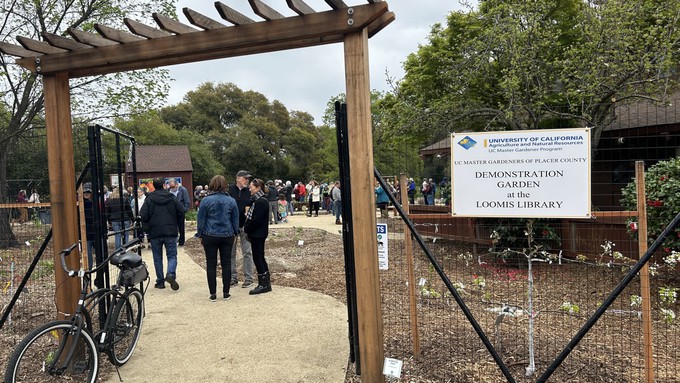
Placer County master gardeners welcome public to experience their growing resource, now in spring bloom

It was late March when the Demonstration Garden first opened at the Loomis Library. Guaranteed there will be more blooms, bigger plants and plenty of sunshine this Saturday for the Spring Open House. Kathy Morrison
On Saturday, June 1, Placer County master gardeners will host their first Spring Open House at their new Demonstration Garden at Loomis Library. Admission is free.
From 10 a.m. to 2 p.m., dozens of master gardeners will be on hand to show visitors what they’ve been working months to create – a total transformation. What was originally 11,000 square feet of unused turf is now a vibrant water-wise garden packed with California natives, pollinator-friendly flowers and edible plants.
“The garden provides an educational environment with areas devoted to pollinator-friendly garden, HOA-friendly garden, rain garden, compost demonstration area, California native woodlands, a lawn-alternative meadow, hedgerows, an edible garden, straw-bale alternative and an orchard,” explain the master gardeners. “The plants and fruit trees are all small but have labels, and the labels have QR codes so visitors can learn more about them.”
Opened earlier this year on the library grounds, the garden will be bursting with spring color, as well as activities for all ages and all levels of gardeners.
“There will be kids activities, information tables staffed with experts in various gardening topics, live music and more,” say the hosts. “Experts will be on hand to answer questions about tool care, irrigation – we will have an expert from Hunter Industries on hand – ‘Ask a Master Gardener’ and vermiculture. Master gardeners will be present to answer questions about the garden and the various beds. We will have experts on California native plants and pollinators as well.”
Loomis Library is located at 6050 Library Drive, Loomis.
For more on the Demonstration Garden: https://pcmg.ucanr.edu/Demonstration_Garden/.
Comments
0 comments have been posted.Sacramento Digs Gardening to your inbox.
Food in My Back Yard Series
April 29: What's (already) wrong with my tomato plants?
April 22: Should you stock up on fertilizer? (Yes!)
April 15: Grow culinary herbs in containers
April 8: When to plant summer vegetables
April 1: Don't be fooled by these garden myths
March 25: Fertilizer tips: How to 'feed' your vegetables for healthy growth
March 18: Time to give vegetable seedlings some more space
March 11: Ways to win the fight against weeds
March 4: Potatoes from the garden
Feb. 25: Plant a fruit tree now -- for later
Feb. 18: How to squeeze more food into less space
Feb. 11: When to plant? Consider staggering your transplants
Feb. 4: Starting in seed starting
Sites We Like
Garden Checklist for week of May 4
Enjoy this spring weather – and get gardening!
* Plant, plant, plant! It’s prime planting season in the Sacramento area. Time to set out those tomato transplants along with peppers and eggplants. Pinch off any flowers on new transplants to make them concentrate on establishing roots instead of setting premature fruit.
* Direct-seed melons, cucumbers, summer squash, corn, radishes, pumpkins and annual herbs such as basil.
* Harvest cabbage, lettuce, peas and green onions.
* In the flower garden, direct-seed sunflowers, cosmos, salvia, zinnias, marigolds, celosia and asters. (You also can transplant seedlings for many of the same flowers.)
* Plant dahlia tubers. Other perennials to set out include verbena, coreopsis, coneflower and astilbe.
* Transplant petunias, marigolds and perennial flowers such as astilbe, columbine, coneflowers, coreopsis, dahlias, rudbeckia and verbena.
* Keep an eye out for slugs, snails, earwigs and aphids that want to dine on tender new growth.
* Feed summer bloomers with a balanced fertilizer.
* For continued bloom, cut off spent flowers on roses as well as other flowering plants.
* Add mulch to the garden to maintain moisture. Mulch also cuts down on weeds. But don’t let it mound around the stems or trunks of trees or shrubs. Leave about a 6-inch to 1-foot circle to avoid crown rot or other problems.